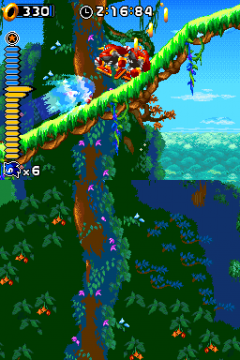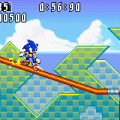- Sonic Generations
- Sonic the Hedgehog
- Sonic the Hedgehog 2
- Sonic CD
- Sonic the Hedgehog 3
- Sonic & Knuckles
- Sonic the Hedgehog 4
- Sonic Mania
- SegaSonic The Hedgehog
- Sonic The Fighters
- Sonic 3D Blast
- Knuckles’ Chaotix
- SegaSonic Bros.
- Sonic the Hedgehog (8-bit)
- Sonic the Hedgehog 2 (8-bit)
- Sonic Chaos
- Sonic the Hedgehog Triple Trouble
- Tails’ Skypatrol
- Tails Adventures
- Sonic Labyrinth
- Sonic Drift
- Sonic Drift 2
- Sonic Blast
- Sonic R
- Murder of Sonic the Hedgehog, The
- Sonic Advance
- Sonic Advance 2
- Sonic Advance 3
- Sonic Rush
- Sonic Rush Adventure

American Cover
After working on Sonic Advance 3, Akinori Nishiyama (the director for all three Advance titles) wanted the next handheld Sonic game to contrast from how complicated the series had gotten by the mid 2000s. This involved going back to a simpler style of gameplay focused purely on speedy action, picking up where Sonic Advance 2 had left off and refining it. The end result would be Sonic Rush, a challenging and stylistically unique platformer that despite some flaws managed to breathe new life into the series during what was considered its lowest point.
You only have two characters to choose from: Sonic himself, and no-nonsense newcomer Blaze the Cat. Blaze is the guardian of the Sol Emeralds, and comes from a parallel world that’s crossing over into and merging with Sonic’s world. Both her and Sonic’s stories involve travelling the land to find the Chaos and Sol Emeralds, fighting against Dr Eggman and his parallel counterpart Eggman Nega (yes really), and occasionally bumping into each other.
There’s significantly more story here, with each character receiving unique cutscenes at the end of each zone, but it doesn’t overstay its welcome. You get a cute simple plot, where the main interest is on Blaze learning to trust others and not having to take on everything alone, and a couple of short cameos from other characters.
Gameplay’s the standard 2D platforming affair, emphasizing speed as you try to reach the end of the level. You can pull off mid-air dashes again with the R button, even after a standard jump. Blaze can’t run as fast as Sonic, but her aerial dashes reach up to higher areas and holding R after jumping lets her slowly descend to the ground. New to Rush is the ability to perform tricks in the air by pressing B and while grinding by pressing R, which gives you extra points and fills up the Tension Gauge.
This is important because at any time, you can press the Y button to activate the Super Boost, which shoots you off at blistering speeds and even through enemies. It’s very powerful but depletes the Tension Gauge in seconds, so your best bet is to keep moving, pulling off tricks, and blasting about the place to top up your meter and keep boosting. If you’re able to fill the meter three times, you can even use unlimited boost for a time.
As usual, you’ll need to get all the Chaos and Sol Emeralds to access the final story, though it’s thankfully much less convoluted than in the Advance games. Blaze gets the Sol Emeralds by defeating the bosses, while Sonic can access Special Stages by boosting on various star-studded swings hidden in each level. These play like the ones from Sonic 2, asking you to collect enough rings while avoiding obstacles to reach the end and get a Chaos Emerald. You can only use the touchscreen to move around, as well as tapping enemies to hit them and pulling off tricks in the air. The controls are more precise and tactile movement, which helps considering how challenging they are.
When you learn how to keep boosting and work together with the level designs, it’s thrilling to blast your way through winding worlds. There’s a nice rhythm in using your various skills to reach and maintain such high speeds, often with a finesse that makes you feel as cool as you look. It’s not surprising the main games began incorporating boosts as the gameplay centrepiece just a few years later.
Unfortunately, the level design doesn’t compliment the gameplay as often as it should. There’s numerous sections that break up the flow like the forced combat rooms where you have to fight enemies, or punish you for boosting at the wrong time with bottomless pits or crushers. Some of the stage gimmicks bring you to a screaming halt with no solution but to wait until they’re done, such as the conveyor belts capping off Mirage Road’s stages or the hang glider sections in Altitude Limit.
It doesn’t help that most of the boss battles are just as bad, asking you to dodge lengthy attack patterns until you’re briefly allowed to hit them. You’re spending ages waiting around, and that’s if you’re lucky or skilled enough to avoid attacks that can throw your rings all over the place or even instantly kill you. The game has an “easy” mode that only affects the bosses, reducing their health from eight hits to six and simplifying their attack patterns, and you’re better off using that if you want to get back to the main game.
Rush can be rather frustrating at times, in how often it gets in its own way and kills the momentum of what’s just as frequently an exciting time. If you’re able to overcome those hurdles, then you’ll have a fast and satisfying game unlike most 2D Sonics, and one with some solid presentation to boot. There’s a nice use of stylish UI elements like vibrant colours, sharp edges and celebratory confetti when you pull off tricks that give the game some pizazz.
The graphics are keen to show off the DS’ power, rendering Sonic, Blaze and certain sections in nice chunky 3D models while displaying the game on both screens and having your character move between them. The latter can be cool, but with so much happening onscreen, it’s often difficult to keep track of your character – especially during vertical platforming sections. Otherwise, it runs well with a slick smooth framerate that keeps up with the speedy action, and a variety of distinct places to check out.
The big shift for Rush is in its music, being the first and only Sonic title composed by Hideki Naganuma, whose distinctive use of samples, scratches and funky high-tempo music had previously established the mood of the Jet Set Radio series. Naganuma’s tracks bring a similar kind of energy here that compliments the gameplay and helps it stand out from the rest of the series, though some of them can become quite abrasive during the trickier and longer levels.
Blaze the Cat was popular enough that she’s since become a regular in the series, appearing in many games (mostly as a side character in spin-offs though sometimes playable) and both the American comic runs by Archie and IDW.
SOURCES:
Nintendo Power Issue 198 (December 2005), pg. 17


